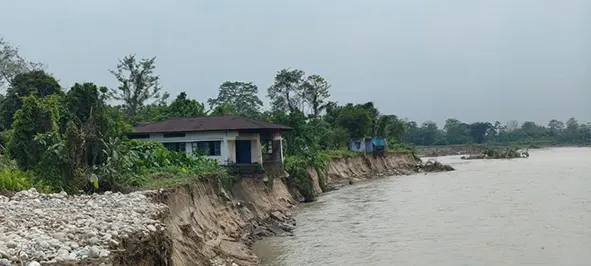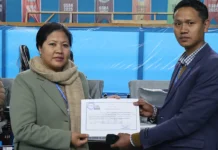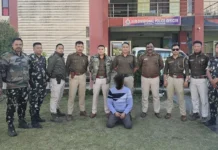[ Samshum Changmi ]
KHARSANG, 29 Apr: The Industrial Training Institute (ITI) in Balinong in Changlang district is facing an existential threat due to severe riverbank erosion caused by the Burhi Dehing River.
Established in 2006, the institute provides training in seven vocational trades and has residential facilities for 48 male and 26 female trainees.
Between April and August last year, widespread flooding in the downstream areas of the Noa-Dehing River (upstream of the Burhi Dehing) caused extensive damage across Kharsang, Bordumsa, Diyun, and Namsai. Recorded as the worst flooding in a decade, it significantly affected ITI Balinong.
Over 10,000 square-metres of land were eroded, resulting in complete destruction of one Type-III staff quarters and two Type-II quarters. Another staff building remains at risk, its foundation exposed as the soil beneath it continues to recede.
This year, as the monsoon arrived unusually early, with heavy rains beginning in March, rivers have swelled beyond danger levels, and erosion has already begun to affect critical infrastructure.
The boys’ hostel has now been partially vacated, forcing trainees to relocate for their safety.
“We are currently managing with a makeshift kitchen covered with tin sheets. However, if the situation persists, we may be compelled to discontinue mid-session,” said a trainee from Longding.
According to sources, some students have been temporarily shifted into remaining staff quarters, while others have sought rental accommodations in nearby Kharsang.
While riverbank erosion is largely a natural phenomenon, one of the major and often overlooked aggravating factors is the rampant illegal sand and boulder mining along the Burhi Dehing riverbanks. This activity extends from Jagun Ghat in downstream Assam to the M’pen area near the Namdapha National Park in Miao.
With the expansion of urban settlements and infrastructure projects, at least eight crusher mills, with a combined annual capacity of 3,80,250 cubic metres, have been established along the banks of the Burhi Dehing River since 2017.
The insatiable demand for minor minerals has led to aggressive extraction from the riverbed. As the limited reserves of notified quarries fail to meet demand, unregulated and illegal mining continues unabated, accelerating the river’s ecological degradation and increasing its erosive force.
Despite multiple appeals from stakeholders, no substantial flood protection measures have yet been implemented. The urgency of the situation calls for immediate and comprehensive intervention.
Key steps should include strict regulation of illegal mining activities, construction of protective infrastructure such as embankments or gabion walls, afforestation along vulnerable riverbanks, and scientific monitoring of the river’s flow dynamics.
Only a firm administrative response, coupled with grassroots vigilance and local cooperation, can safeguard the ITI Balinong and the futures of those who rely on it. Without timely action, even the proposed 30.50-hectare multi-product special economic zone in Balinong may not remain safe from the river’s relentless encroachment.




